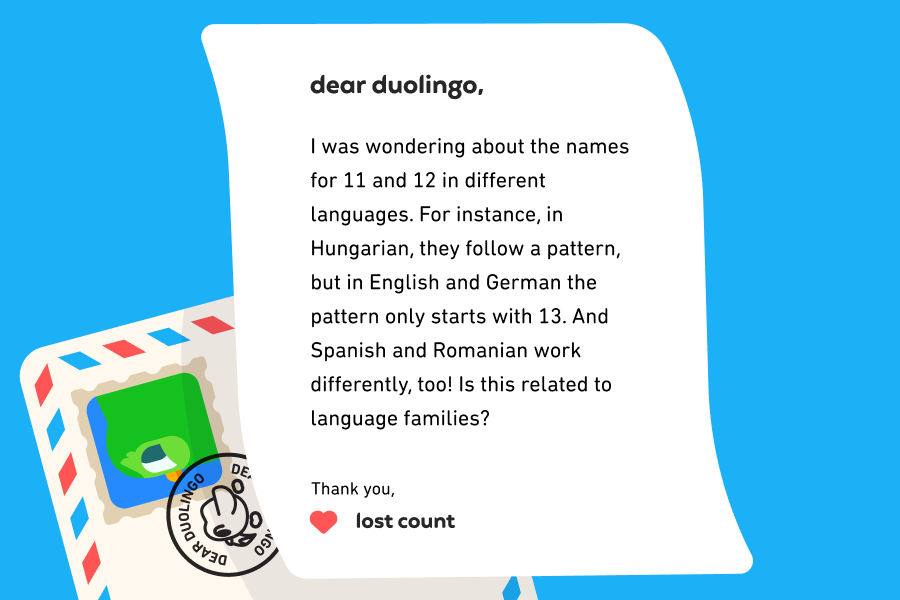Welcome to another week of Dear Duolingo, an advice column just for learners. Catch up on past installments here.
Hi, learners! This week we have a very special Dear Duolingo from learning experts Dr. Cassie Freeman and Alison Falco, from Duolingo’s math team! This week’s question is about the intersection of math and language, and it comes during a momentous week at Duolingo: We’re celebrating our twelfth anniversary! Here’s this week’s question:
Our question this week

What a great observation! You are right that part of the reason has to do with language families—but there is another reason that has to do with our brains… and human history!
The history of counting
The first thing to know about counting is how we got started doing it. Thousands of years ago, people did not have the need to count very high. We only ever needed to keep track of relatively small numbers of things, like members of a society, animals in a herd, or days.
As a result, small counting numbers—particularly those that could be counted on our fingers (and toes)—were treated differently from larger numbers. In fact, tally marks, which count in groups of 5, can be traced back to nearly 30,000 years ago! The names for larger numbers, and the patterns used to name them, came about later.
That’s why in many languages, there are particular names for the numbers before 10 (like one, two, and three) but a pattern is used for numbers right after 10.
What’s so special about 10?
Because we started by counting small sums with our fingers, one number got a special place in many cultures: 10.
In these cultures, 10 became a natural benchmark for counting in our everyday lives, and our languages reflect that! For groups that base their counting on 10, smaller numbers are described as parts of 10 (“4.3” is four and three tenths) and larger numbers are described in groups of 10 (“20” was literally two groups of 10 in Old English).
Over time, 10, and powers of 10 like 100 (102), have become the basis of many real-world systems we use today, including:
- the metric system (100 centimeters = 1 meter)
- temperature in Celsius (0° and 100°)
- money (100 cents in 1 dollar)
- time (10 years in a decade, 100 years in a century)
But 10 isn’t the only counting base in use! Others include base-12 (24 hours in a day, 12 months in a year, 12 inches in a foot… or a dozen donuts 🍩), base-20, and even base-27.
How 10 changed how we name numbers
The importance of the number 10 is the reason why the words for 11 and 12 are often different from 13 through 19. The words themselves describe a mini calculation!
The words eleven and twelve came about through subtraction. Eleven means one remaining after 10 have been counted (from the Old English word enleofan “one left”), and twelve means two remaining after 10 have been counted (two left [after 10]).

After 12, English and German follow a pattern of using the ending -teen (which stands for ten). Other languages have sort of “weird” words until their pattern starts at 16.
Some languages have a transparent pattern right after 10. Japanese, Mandarin, and Korean all follow a regular naming pattern for 11–19, similar to “ten-one,” “ten-two,” and all the way to “ten-nine.” This transparent number naming system even makes it a little easier for young children to start learning math!
| English | German | Spanish | French | Japanese | |
|---|---|---|---|---|---|
| 10 | ten | zehn | diez | dix | 十 (juu) |
| 11 | eleven | elf | once | onze | 十一 (juu ichi) |
| 12 | twelve | zwölf | doce | douze | 十二 (juu ni) |
| 13 | thirteen | dreizehn | trece | treize | 十三 (juu san) |
| 14 | fourteen | vierzehn | catorce | quatorze | 十四 (juu shi or juu yon) |
| 15 | fifteen | fünfzehn | quince | quinze | 十五 (juu go) |
| 16 | sixteen | sechzehn | dieciséis | seize | 十六 (juu roku) |
| 17 | seventeen | siebzehn | diecisiete | dix-sept | 十七 (juu shichi or juu nana) |
Math and language intersect in *dozens* of ways!
So, just like in your Duolingo courses, there’s long been a connection between math and language! And this week, we’ll be thinking especially about how this *could have been* Duolingo’s anniversary number two-teen or tenty-two 🤓
For more answers to your math and language questions, get in touch with us by emailing dearduolingo@duolingo.com.
